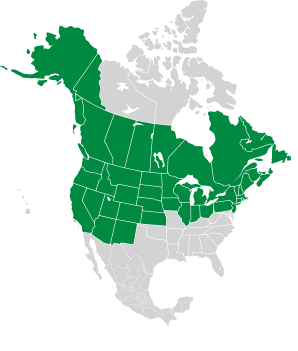Actaea eburnea Rydb.
Actaea neglecta Gillman
Actaea arguta var. alabastrina Lunell.
Actaea arguta var. eburnea (Rydb.) Cockerell

|
Actaea rubra f. neglecta (Gillmann) B.L.Rob. White-fruited red baneberry
Seriously? You’ve got your white-fruited baneberry. Your red-fruited baneberry. A type of white-fruited baneberry that produces red fruit. And this, a type of red-fruited baneberry that produces white fruit. Go figure. White-fruited red baneberry is a North American native, though the only information I can find on the natural species is that Kew Gardens lists the species name as an accepted name. A few gardening outlets list it. Plants: White-fruited red baneberry is 1-3′ (30-91 cm) high. Leaves: On all of the baneberries, leaves often occur in groups of three, on thin stems, and are saw-toothed. Individual leaves are somewhat divided into three sections. Flowers: Flowerheads are roughly spherical (racemes) of small white or purple flowers ¼″ (6.3 mm) across, with a roselike odor. Flowerheads appear soft and feathery. They appear in May. Fruits: Berries are oval when green, becoming rounder and white when ripe. Edibility: Some variants are compared below: |
6/15/2010 · Garden in the Woods, Framingham, Massachusetts · ≈ 8 × 5″ (19 × 13 cm) 6/15/2010 · Garden in the Woods, Framingham, Massachusetts · ≈ 2 × 1′ (62 × 41 cm) |
|||||||||||||||||||||||||||||||
|
| ||||||||||||||||||||||||||||||||
Actaea pachypoda |
Actaea pachypoda f. rubrocarpa |
Actaea rubra |
||||||||||||||||||||||||||||||
|---|---|---|---|---|---|---|---|---|---|---|---|---|---|---|---|---|---|---|---|---|---|---|---|---|---|---|---|---|---|---|---|---|
| Common Name |  |
 |
 |
|||||||||||||||||||||||||||||
| Plant | ||||||||||||||||||||||||||||||||
| Flowers | Flowerheads of small white flowers are roughly oval in shape. Each flower is ¼″ (6.3 mm) across. | Flowerheads of small white flowers are roughly oval in shape. Each flower is ¼″ (6.3 mm) across. | Feathery flowerheads of small white flowers are roughly oval in shape. Each flower is ¼″ (6.3 mm) across. Flowers have a roselike fragrance. | |||||||||||||||||||||||||||||
| Leaves | ||||||||||||||||||||||||||||||||
| Fruit | White berries supported by red pedicels that are ⅛″ (3 mm) or more in thickness. Berry tips have black-purple spot. | Red berries supported by pedicels that are ⅛″ (3 mm) or more in thickness. Instead of the tomato red of red baneberry, these berries have a more luminous deep magenta color, becoming more purplish with time. | Bright or dark red, oval berries are supported by pedicels that are less than ⅛″ (3 mm) thick. | |||||||||||||||||||||||||||||
| Range/ Zones |
|
|
|
|||||||||||||||||||||||||||||
| Habitats | Actaea racemosa | |||||||||||||||||||||||||||||||
| Type | Wild | Wild | Wild | |||||||||||||||||||||||||||||
| Occurrence | Common | Rare | Common | |||||||||||||||||||||||||||||


Online References:
Actaea eburnea Rydb.
Actaea neglecta Gillman
Actaea arguta var. alabastrina Lunell.
Actaea arguta var. eburnea (Rydb.) Cockerell
Actaea rubra f. neglecta description by Thomas H. Kent, last updated 16 Sep 2020.
© FloraFinder.org. All rights reserved.
Range:
